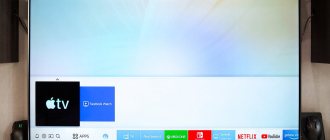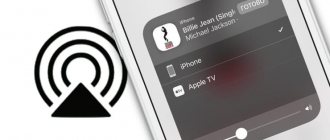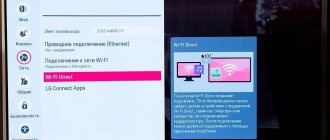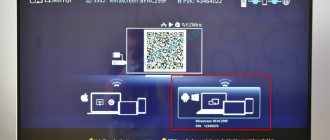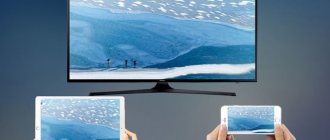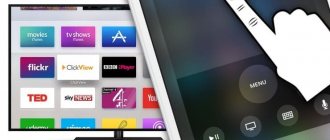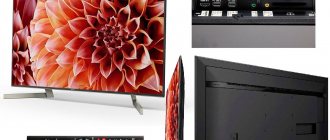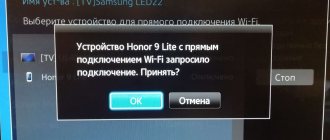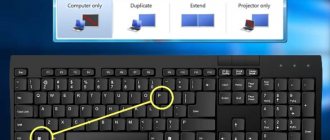One of the signature features of the Apple ecosystem is the AirPlay wireless audio and video transmission protocol. The option debuted back in the days of iOS 4, and in one of the iOS 11 updates it “grew up” to the second generation with support for multiroom technology.
The protocol is not completely closed; third-party developers can build the feature into their multimedia systems, speakers and TVs. Unfortunately, this feature is implemented only in a small number of devices on the market.
Now we’ll tell you how to add AirPlay support to any audio device or TV.
What is airplay and how does the technology work?
Before you start using the airplay function, you need to understand what screen mirroring is on an iPhone. So, airplay is a technology for transferring media files over a local network, without the use of wires and cables, between Apple products and third-party compatible devices. The principle of operation of apple airplay is as follows:
- the acoustic device connects to the WiFi network;
- the sound source is reflected (for example, an iPhone mobile device);
- the user launches the desired file.
Since the function works wirelessly, the owner can be in another room.
iPhone screen mirroring technology was developed in 2010. The technology replaced AirTunes, whose functionality was limited only to the transfer of audio files, and was closed. The appearance of an “updated version” of AirTunes made it possible to pair with equipment from other manufacturers.
At the same time, in comparison with sound transmitted via Bluetooth, users note that the sound quality via airplay is better.
The concept of “screen mirroring” means duplicating the screen of gadgets with iOS software on devices with AirPlay support. This function allows you to stream video and audio files, but there is a ban that limits the transfer of files for copyright protection purposes. So, for example, when you turn on the screen with Apple Music, only a touch window will appear on the screen of the paired device.
In the control center, on the “Now Playing” widget, which is located on the right side of the display that opens, you need to click on the wireless playback icon. The button is pressed until a list of available receiver devices appears on the tap. All that remains is to select the desired option. The smartphone will automatically start playing on the selected media.
Apple AirPlay connection to Samsung TV:
By cable
A cable connection from an Apple phone to LG TV will require the purchase of an appropriate adapter, since the iPhone has only one connector for connecting to other devices and the same for charging the smartphone.
USB
Connecting to TV via a USB port is not easy, but very simple: one end of the USB cable is inserted into the smartphone, and the other into the corresponding port on the TV.
- For iPhone version 4 and older, you will need a special Apple USB cable.
- Starting from version 5 of the iPhone, a special Apple Lightning to USB Adapter is used.
The final step is to select USB mode in the TV settings (“Signal source”).
When connecting a smartphone to a TV via a USB port, the iPhone acts as a storage medium. Simply put: it is possible to view only photos and/or videos loaded into the device’s permanent memory. Broadcasting directly from, for example, YouTube is not possible.
HDMI
Connecting your iPhone to your TV via HDMI is the best option for watching high quality videos (Full HD).
To connect two devices you will need adapters:
- iPhone version 4 and older - AV Adapter Digital.
- iPhone version 5 and higher - AV Adapter Lightning.
This connection does not require any special settings and the steps look exactly the same as a USB connection:
- The adapter connects to the smartphone.
- The HDMI cable is connected to the adapter at one end and to the TV at the other.
- Device reading and configuration occurs automatically.
- In the TV settings, HDMI is indicated as the signal source. If there are several HDMI ports on the TV, indicate the one to which the smartphone is connected.
The only disadvantage of this connection is the short HDMI cable. The limitation is caused by the impossibility of transmitting a signal over a long “cord” without loss of quality.
Analog cable
Owners of “morally outdated” LG TVs should not be upset: videos and images from Apple smartphones can also be viewed on the TV screen. Older TV models have a composite input for video and audio. In order to connect your phone to TV you will need one of three types of cable:
- USB AV - for Apple smartphones version 4s and older. Three “tulip” plugs are connected to the TV, a 30-pin plug is connected to the smartphone.
- AV HDTV from Apple - for phones version 4 and 4s. The quality of the signal transmitted via this cable is improved thanks to sync plugs.
- Lightning VGA adapter - for iPhone version 5 and higher. In addition to the adapter, you will need a VGA cable.
Reference! Connecting via an analog input does not require special settings; it is only important to pay attention to the matching colors of the “tulip” plugs and the TV inputs.
After connecting, you need to select the appropriate “Signal Source” in the settings.
AirPlay 2 - distinctive features
Apple developers presented an updated version of AirPlay at the WWDC 2021 conference. Despite the fact that AirPlay 2 functions were planned to be added to the 11th edition of iOS 116, the market saw an update to the familiar screen repeat only in 2021. The main feature of airplay 2, and at the same time the difference from the previous version, was the function of supporting multiroom mode. Thanks to the update, users have the opportunity to use multiple devices to play music.
Supports the updated version of iPhone 5S, iPhone SE and later models. For iPad, these are iPad mini 2, 3, 4, iPad Air, 2 and later, and the sixth generation iPod touch. To summarize, all devices that were released no more than 7 years ago.
Multiroom mode involves simultaneous broadcasting of sound to several Apple TVs, which can be located in different rooms. This also applies to HomePod speakers, or HomePod and Apple TV.
Moreover, the combinations may vary depending on the user’s preferences and the devices available to him. The developers have taken care of ease of use - you can control the broadcast of files on different gadgets, and adjust the playback volume parameters separately for each object from the “Home” application. Thus, the owner has the opportunity to customize an entire audio system, each component which is interconnected with the others, since Apple does not provide restrictions on the choice of devices.
The update includes a new playlist that any user can access, which is convenient for events and parties. Music is played in order of priority. The ability to pair with a smart home allows you to simultaneously connect music and, for example, smart light bulbs.
A timer is available to set playback to start automatically. This is useful if there is a need to create the appearance of people in the house.
Multiroom mode involves simultaneous broadcasting of sound to several Apple devices
Connection via additional devices
To connect your iPhone to your TV, you can use additional devices. Most often used:
- Google Chromecast;
- Apple TV.
Google Chromecast allows you to connect your TV and an iOS-controlled device. Externally, the device resembles a flash drive. Chromecast connects to a mobile device via a cable, and to a TV via an HDMI port. Thanks to Chromecast, you can watch movies, play games, and surf the Internet. No special knowledge is required to set up the device.
As for Apple TV, it is a multimedia player. To configure the device, you must sequentially perform the following steps:
- Turn on the TV and Apple TV receiver;
- Switch TV to input signal;
- The device interface will appear on the screen. It is recommended to double-check the settings;
- Connect your iPhone to your home network via a wireless connection.
After this, all devices will be synchronized. All that remains is to transfer any video files or graphic images to the TV.
Airplay compatibility, which devices support it
On the modern market you can find many options for wireless speaker stations, while manufacturers offer to purchase a product that is the embodiment of technological progress. The ability to view content from Apple devices on third-party devices is available thanks to the AirPlay function.
A prerequisite for establishing compatibility is connecting to a single Wi-Fi network. This means that the connection range is limited by the coverage area of the local network - you won’t be able to play a file from another city on your home audio system. Depending on which device the file originates from and which receives, compatible devices are divided into two categories: senders and receivers. The first group includes:
- Computers with iTunes installed.
- On iPhone, iPad, and iPod products running iOS 4.2 or later.
- Apple TV;
- Mac PC running macOS Mountain Lion and later.
Receivers include:
- AirPort Express.
- Apple TV.
- Apple HomePod.
- Any third-party devices that support AirPlay.
The connection will take no more than 10 minutes; the user will only need to make a couple of clicks on the smartphone.
backward compatibility
AirPlay 2 is backwards compatible. This means that your iPhone updated to AirPlay 2 can still work with “legacy” music systems with the previous version of the protocol, but you won’t be able to add these speakers to multiroom and HomeKit.
Users may encounter the following problem: starting music on a regular AirPlay speaker will stop playback on all other “new” systems with AirPlay 2. If you have so many speakers that you get confused, then through the “Control Center” you can always check which ones speakers visible on the network are compatible with the new version of the protocol, and which ones only support regular AirPlay.
Original: Airplay 2: What you need to know
How to enable AirPlay
It's important to understand that a powerful tool like AirPlay delivers its functionality differently on macOS and iOS. In order to start mirroring the screen of an iPhone or iPad, you will need to open Control Center. Select the screen duplication option, which will be located on the left side. The window that appears will display the nearest available device. This is where the broadcast stops.
If you need to display information from the Mac screen on Apple TV via Airplay, then open system settings, iTunes or QuickTime. In the menu section, AirPlay is selected. On macOS Big Sur and later, the easiest way to start screen mirroring is through the Control Center icon.
In order to output material from an iPhone or iPad to a Windows computer, you will need to “bypass” the Apple developers, since it is impossible to use a third-party device as a receiver.
If necessary, you can duplicate the screen on Windows or Android TV; you will have to use third-party utilities, for example, AirServer (https://apps.apple.com/ru/app/airserver-connect/id967004087) or Reflector (https://play.google .com/store/apps/details?id=com.squirrels.reflector&hl=ru&gl=US). These applications are not free and you will have to pay about $20. In some cases, it is possible to obtain free use for several weeks.
How to enable AirPlay - video instructions:
To mirror (repeat) the iPhone or iPad screen
1. Open Control Center.
2. Tap Screen Repeat on the left side of the screen.
3. Wait until the nearest AirPlay device appears on your display.
4. Select the receiver to which you want to display the image.
To stop broadcasting, repeat the process by selecting “Stop Screen Repeat” in step 4.
♥ ON TOPIC: 17 hidden features of VKontakte that you might not know about.
Airplay on TV
As practice shows, the easiest and fastest way to connect an iPhone to Smart-TV is to establish a WiFi connection, that is, via AirPlay. To establish pairing, no wires are required, only a local network.
When synchronizing airplay and Samsung, LG, Sony TV, you only need to first install a special application on both gadgets, namely the AllShare utility. The application is one of the utilities provided by Smart-TV. After downloading the application, the user can gain control over the smart TV display, which is required to broadcast media files located on the smartphone.
Connection options
When choosing a method that allows you to connect an iPhone to an LG TV, you need to find out whether the TV has a Wi-Fi module. If the device is old enough, it may not have a wireless communication module, but it probably has USB, HDMI or analog input ports.
It is also possible to connect your iPhone to your TV via Apple TV, AirPlay and Google Chromecast.
Possible problems and their solutions
The main problem that users have is the lack of broadcast or file playback, which appears due to the absence or disruption of the connection between devices. The first thing you need to do if you can't stream content smoothly using AirPlay is to make sure that the devices are turned on and are close to each other (connected to the same network). If this does not help, then you should restart both gadgets.
If restarting does not lead to the expected result, then you need to check the settings for the presence of a suitable update. The WiFi wireless connection is in the 2.4 GHz band, in which other equipment also operates - many devices with Bluetooth, some of the systems that are part of the so-called “smart home”. So, if you turn on a Sonos speaker system and an AirPlay-enabled WiFi-based speaker system at the same time, interference may occur.
Music playback may be paused if Siri is multitasking. If there is no sound at all, then you need to check it in the settings system (check the status of the silent mode). If the source of the problem cannot be identified on your own, Apple support will answer all your questions.
Why connect your smartphone to your TV?
An ordinary TV without Internet access has extremely limited functionality - it can only be used to watch TV programs on available channels. However, this narrows the choice, and the quality of television content continues to decline. If you figure out how to connect an iPhone to a TV, you can significantly expand its capabilities. The following functionality becomes available to the user:
- Watching all kinds of films and videos from YouTube. You can watch them on the big screen, enjoying the quality of the image and sound. In this case, the TV is used as a monitor to which the picture is transmitted.
- Internet surfing. You will be able to visit any website, view pages on social networks, search for the information you need and display it on the big screen.
- Video calls using modern instant messengers. A clear picture will be displayed on the TV screen, this will make communication with friends and family much more enjoyable.
- Conducting business video conferences, which is especially important for office employees.
Is it possible to connect an iPhone to a TV if you have a regular model at home with outdated capabilities? There will be no connection problems, since you can use several methods for this.
Other Airplay features
In addition to the main function - broadcasting video files and mirroring the screen on an iPhone, Apple TV and other devices, there are third-party AirPlay capabilities, which include:
- Using the Siri voice assistant to play files and control playback of recordings or broadcasts.
- Stream music, podcasts, and other files to Apple TV , HomePod, and other streaming systems that support airplay.
- For ease of use, the user can immediately add compatible playing centers and TVs to the Home application .
- To resolve issues that arise when working with devices, the developers have prepared detailed instructions (https://support.apple.com/ru-ru/HT204289).
Thus, the Airplay technology developed by Apple is another leap in the world of technology. The main task of wireless file playback is to facilitate the operation process and use of a smart home system. Thanks to Airplay, choosing movies and listening to audio files has become much easier.
How to change the Apple TV name
If you have multiple Apple TV boxes or your neighbor's Apple TV constantly appears in the list of devices, you can give the receivers unique names. To do this, open “Settings” → “General” → “About this device” → “Name”.
♥ ON TOPIC: Apple TV: Secrets and tips for use.
